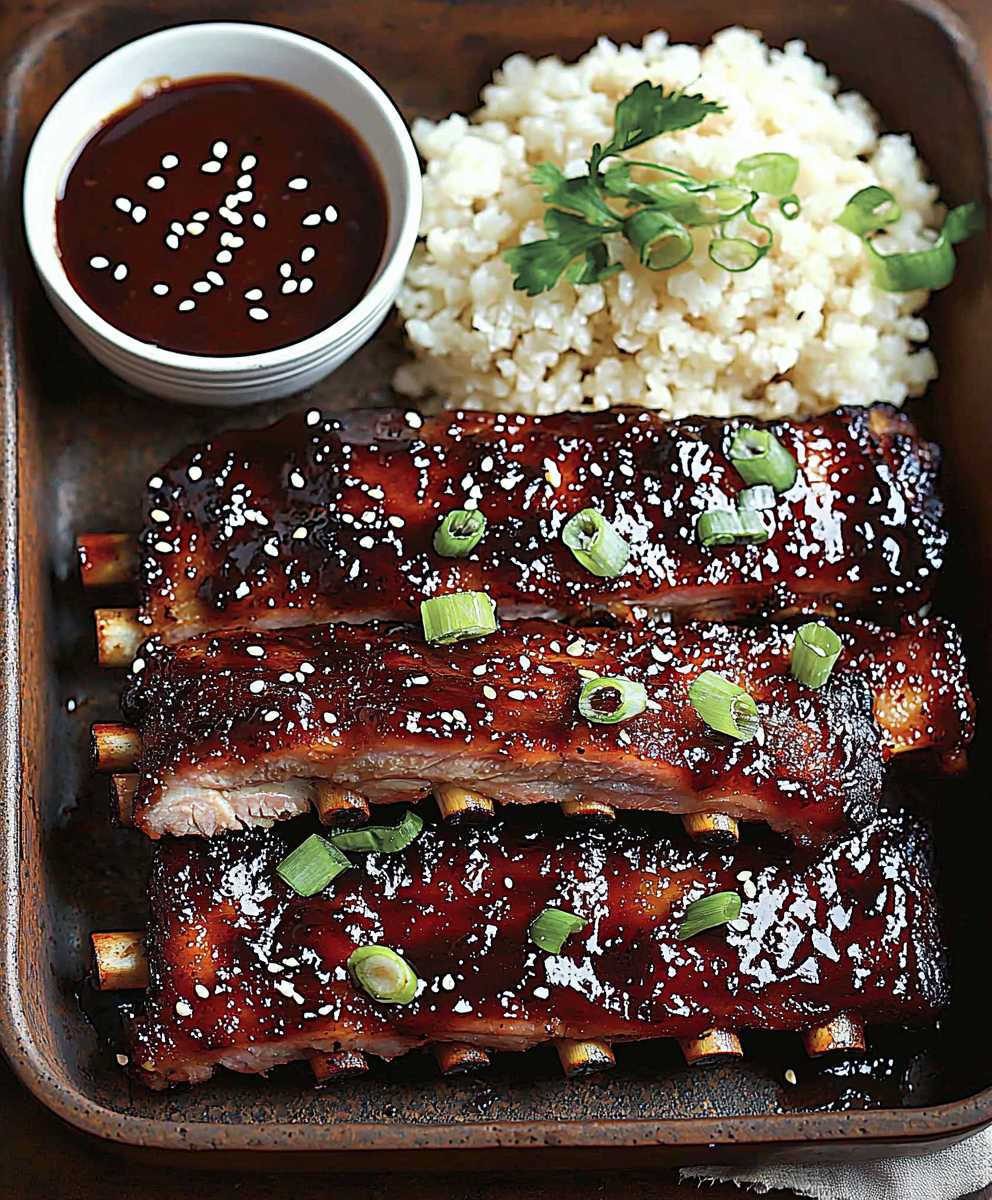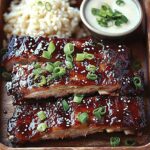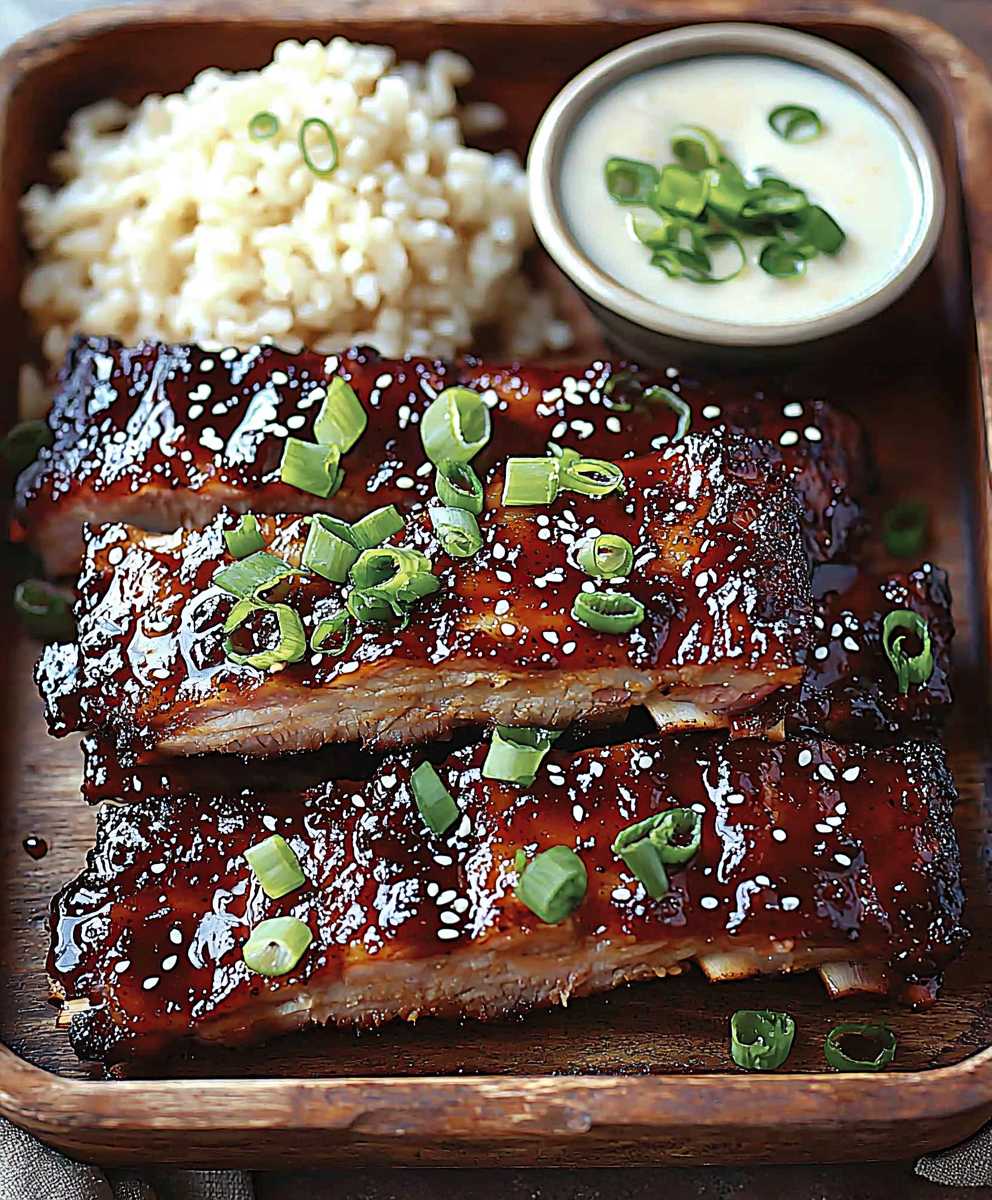Sticky Asian Pork Ribs: Prepare to embark on a culinary adventure that will tantalize your taste buds and leave you craving more! Imagine sinking your teeth into tender, fall-off-the-bone ribs, glazed with a luscious, sweet, and savory sauce that perfectly balances umami and a hint of spice. This isn’t just a recipe; it’s an experience.
Ribs, in general, have a long and storied history, enjoyed in various forms across cultures for centuries. In Asian cuisine, the art of glazing meats with complex, flavorful sauces is a time-honored tradition, often associated with celebratory feasts and family gatherings. These Sticky Asian Pork Ribs draw inspiration from these traditions, blending classic techniques with modern convenience.
What makes this dish so irresistible? It’s the symphony of flavors, the satisfyingly sticky texture, and the sheer joy of eating with your hands! The combination of tender pork, a glistening glaze, and aromatic spices creates a truly unforgettable culinary experience. Plus, while they might seem intimidating, these ribs are surprisingly easy to make at home, making them perfect for a weekend gathering or a special weeknight treat. Get ready to impress your friends and family with this show-stopping dish!
Ingredients:
- For the Ribs:
- 4 pounds pork spareribs, cut into individual ribs or racks
- 2 tablespoons vegetable oil
- 1 large onion, chopped
- 4 cloves garlic, minced
- 1 inch ginger, peeled and grated
- For the Sticky Asian Glaze:
- 1 cup soy sauce (low sodium preferred)
- 1/2 cup honey
- 1/4 cup rice vinegar
- 2 tablespoons brown sugar, packed
- 2 tablespoons sesame oil
- 1 tablespoon sriracha (or more, to taste)
- 1 teaspoon ground ginger
- 1/2 teaspoon garlic powder
- 1/4 teaspoon red pepper flakes (optional)
- 2 tablespoons cornstarch
- 1/4 cup cold water
- For Garnish (optional):
- Sesame seeds
- Chopped green onions
Preparing the Ribs:
- Prepare the Ribs: If you bought a full rack of spareribs, you’ll need to cut them into individual ribs or smaller racks. I prefer cutting them into smaller racks of 3-4 ribs each, as they’re easier to handle and cook evenly. Pat the ribs dry with paper towels. This helps them brown nicely.
- Sear the Ribs (Optional but Recommended): While this step isn’t strictly necessary, searing the ribs before braising adds a wonderful depth of flavor. Heat the vegetable oil in a large, heavy-bottomed pot or Dutch oven over medium-high heat. Working in batches, sear the ribs on all sides until nicely browned. Don’t overcrowd the pot, or the ribs will steam instead of sear. Remove the seared ribs from the pot and set aside.
- Sauté Aromatics: Reduce the heat to medium. Add the chopped onion to the pot and cook until softened and translucent, about 5-7 minutes. Add the minced garlic and grated ginger and cook for another minute, until fragrant. Be careful not to burn the garlic.
- Return Ribs to the Pot: Place the seared ribs back into the pot with the onions, garlic, and ginger.
Making the Sticky Asian Glaze:
- Combine Glaze Ingredients: In a medium bowl, whisk together the soy sauce, honey, rice vinegar, brown sugar, sesame oil, sriracha, ground ginger, garlic powder, and red pepper flakes (if using).
- Pour Glaze Over Ribs: Pour the glaze over the ribs in the pot. Make sure the ribs are mostly submerged in the liquid. If necessary, add a little water or chicken broth to cover them.
- Bring to a Simmer: Bring the mixture to a simmer over medium heat. Once simmering, reduce the heat to low, cover the pot, and let the ribs braise for 2-3 hours, or until they are very tender and the meat is easily falling off the bone. Check the ribs occasionally and add more liquid if needed to prevent them from drying out. The braising time will depend on the size and thickness of your ribs.
Thickening the Glaze and Finishing the Ribs:
- Remove Ribs from Pot: Once the ribs are tender, carefully remove them from the pot and place them on a baking sheet lined with parchment paper or foil.
- Thicken the Glaze: In a small bowl, whisk together the cornstarch and cold water to create a slurry. Pour the cornstarch slurry into the pot with the braising liquid. Bring the liquid to a simmer over medium heat and cook, stirring constantly, until the glaze has thickened to your desired consistency. This should only take a few minutes.
- Glaze the Ribs: Brush the thickened glaze generously over the ribs on the baking sheet.
- Broil or Bake (Optional): For an extra sticky and caramelized finish, you can broil the ribs for a few minutes, watching them closely to prevent burning. Alternatively, you can bake them in a preheated oven at 375°F (190°C) for 10-15 minutes, or until the glaze is bubbly and caramelized.
- Serve: Garnish the ribs with sesame seeds and chopped green onions, if desired. Serve immediately and enjoy! These ribs are fantastic with steamed rice, noodles, or your favorite Asian-inspired side dishes.
Tips for Perfect Sticky Asian Pork Ribs:
- Choose the Right Ribs: Spareribs are the classic choice for this recipe, but baby back ribs will also work. Spareribs are meatier and have more fat, which makes them incredibly flavorful and tender when braised.
- Don’t Skip the Searing: Searing the ribs adds a wonderful depth of flavor that you won’t get if you skip this step. It’s worth the extra effort!
- Adjust the Spice Level: If you’re sensitive to spice, start with a smaller amount of sriracha and add more to taste. You can also omit the red pepper flakes altogether.
- Control the Heat: Braising is a gentle cooking method, so it’s important to keep the heat low and slow. This will ensure that the ribs become incredibly tender without drying out.
- Don’t Overcrowd the Pot: When searing the ribs, work in batches to avoid overcrowding the pot. Overcrowding will lower the temperature of the oil and cause the ribs to steam instead of sear.
- Adjust the Glaze Consistency: If you prefer a thicker glaze, use a little more cornstarch. If you prefer a thinner glaze, use a little less.
- Let the Ribs Rest: After braising, let the ribs rest for a few minutes before glazing them. This will allow the juices to redistribute, resulting in even more flavorful ribs.
- Broiling Tips: When broiling the ribs, keep a close eye on them to prevent burning. The glaze can caramelize quickly under the broiler, so it’s important to watch them carefully.
- Make Ahead: You can braise the ribs ahead of time and store them in the refrigerator for up to 2 days. When you’re ready to serve, simply glaze them and broil or bake them until heated through.
- Freezing: Cooked ribs can be frozen for up to 2 months. Wrap them tightly in plastic wrap and then in foil to prevent freezer burn. Thaw them overnight in the refrigerator before reheating.
Serving Suggestions:
- Steamed Rice: A classic pairing for Asian-inspired dishes. The rice soaks up the delicious glaze perfectly.
- Noodles: Try serving the ribs with lo mein noodles, udon noodles, or soba noodles.
- Asian Slaw: A refreshing and crunchy slaw made with shredded cabbage, carrots, and a tangy Asian dressing.
- Stir-Fried Vegetables: A quick and easy side dish that complements the richness of the ribs.
- Edamame: A simple and healthy snack or side dish.
- Kimchi: A spicy and fermented Korean side dish that adds a kick to the meal.
- Pickled Vegetables: Pickled cucumbers, carrots, or daikon radish add a tangy and refreshing element to the meal.
Variations:
- Spicy Ribs: Add more sriracha or red pepper flakes to the glaze for a spicier kick. You can also add a pinch of cayenne pepper.
- Sweet and Sour Ribs: Add a tablespoon of ketchup to the glaze for a sweet and sour flavor.
- Garlic Ribs: Add more minced garlic to the glaze for a more intense garlic flavor.
- Honey Garlic Ribs: Increase the amount of honey in the glaze for a sweeter and stickier glaze.
- Ginger Ribs: Add more grated ginger to the glaze for a more pronounced ginger flavor.
- Five-Spice Ribs: Add a teaspoon of Chinese five-spice powder to the glaze for a complex and aromatic flavor.
- Slow Cooker Ribs: You can also make these ribs in a slow cooker. Simply combine all the ingredients in the slow cooker and cook on low for 6-8 hours, or on high for 3-4 hours. Then, remove the ribs, thicken the glaze, and glaze the ribs as directed in the recipe.
- Instant Pot Ribs: For a quicker cooking method, try making these ribs in an Instant Pot. Combine all the ingredients in the Instant Pot and cook on high pressure

Conclusion:
And there you have it! These Sticky Asian Pork Ribs are truly a game-changer. I know, I know, I might be biased, but trust me on this one. The combination of the tender, fall-off-the-bone meat with that sweet, savory, and slightly spicy glaze is simply irresistible. It’s the kind of dish that will have your family and friends begging for seconds, and maybe even the recipe! But why is this recipe a must-try? It’s more than just delicious; it’s surprisingly easy to make. Forget spending hours slaving over a smoker or dealing with complicated techniques. This recipe utilizes a simple oven-baking method that yields incredibly tender and flavorful ribs every single time. The marinade does all the heavy lifting, infusing the pork with a depth of flavor that’s usually reserved for professional chefs. Plus, the glaze is quick to whip up and adds that perfect sticky, caramelized finish that makes these ribs truly special. It’s a guaranteed crowd-pleaser that requires minimal effort what’s not to love? Beyond the incredible flavor and ease of preparation, these ribs are incredibly versatile. Looking for serving suggestions? I highly recommend pairing them with a side of fluffy white rice to soak up all that delicious sauce. A simple Asian slaw with a sesame ginger dressing would also be a fantastic complement, adding a refreshing crunch to balance the richness of the ribs. For a heartier meal, consider serving them alongside some roasted sweet potatoes or grilled corn on the cob. And don’t be afraid to experiment with variations! If you’re a fan of spice, add a pinch of red pepper flakes to the marinade or glaze for an extra kick. For a sweeter flavor profile, try incorporating a touch of honey or maple syrup into the glaze. You could even experiment with different types of Asian sauces, such as hoisin sauce or black bean sauce, to create your own unique flavor combination. The possibilities are endless!Serving Suggestions & Variations
- Classic: Serve with steamed rice and a side of Asian slaw.
- Spicy: Add red pepper flakes to the marinade or glaze.
- Sweet: Incorporate honey or maple syrup into the glaze.
- Hearty: Pair with roasted sweet potatoes or grilled corn.
- Experiment: Try different Asian sauces like hoisin or black bean.

Sticky Asian Pork Ribs: The Ultimate Guide to Deliciousness
- Total Time: 230 minutes
- Yield: 4–6 servings 1x
Description
Tender and flavorful pork spareribs braised in a sticky, sweet, and savory Asian-inspired glaze.
Ingredients
- 4 pounds pork spareribs, cut into individual ribs or racks
- 2 tablespoons vegetable oil
- 1 large onion, chopped
- 4 cloves garlic, minced
- 1 inch ginger, peeled and grated
- 1 cup soy sauce (low sodium preferred)
- 1/2 cup honey
- 1/4 cup rice vinegar
- 2 tablespoons brown sugar, packed
- 2 tablespoons sesame oil
- 1 tablespoon sriracha (or more, to taste)
- 1 teaspoon ground ginger
- 1/2 teaspoon garlic powder
- 1/4 teaspoon red pepper flakes (optional)
- 2 tablespoons cornstarch
- 1/4 cup cold water
- Sesame seeds
- Chopped green onions
Instructions
- Prepare the Ribs: If you bought a full rack of spareribs, you’ll need to cut them into individual ribs or smaller racks. I prefer cutting them into smaller racks of 3-4 ribs each, as they’re easier to handle and cook evenly. Pat the ribs dry with paper towels. This helps them brown nicely.
- Sear the Ribs (Optional but Recommended): While this step isn’t strictly necessary, searing the ribs before braising adds a wonderful depth of flavor. Heat the vegetable oil in a large, heavy-bottomed pot or Dutch oven over medium-high heat. Working in batches, sear the ribs on all sides until nicely browned. Don’t overcrowd the pot, or the ribs will steam instead of sear. Remove the seared ribs from the pot and set aside.
- Sauté Aromatics: Reduce the heat to medium. Add the chopped onion to the pot and cook until softened and translucent, about 5-7 minutes. Add the minced garlic and grated ginger and cook for another minute, until fragrant. Be careful not to burn the garlic.
- Return Ribs to the Pot: Place the seared ribs back into the pot with the onions, garlic, and ginger.
- Combine Glaze Ingredients: In a medium bowl, whisk together the soy sauce, honey, rice vinegar, brown sugar, sesame oil, sriracha, ground ginger, garlic powder, and red pepper flakes (if using).
- Pour Glaze Over Ribs: Pour the glaze over the ribs in the pot. Make sure the ribs are mostly submerged in the liquid. If necessary, add a little water or chicken broth to cover them.
- Bring to a Simmer: Bring the mixture to a simmer over medium heat. Once simmering, reduce the heat to low, cover the pot, and let the ribs braise for 2-3 hours, or until they are very tender and the meat is easily falling off the bone. Check the ribs occasionally and add more liquid if needed to prevent them from drying out. The braising time will depend on the size and thickness of your ribs.
- Remove Ribs from Pot: Once the ribs are tender, carefully remove them from the pot and place them on a baking sheet lined with parchment paper or foil.
- Thicken the Glaze: In a small bowl, whisk together the cornstarch and cold water to create a slurry. Pour the cornstarch slurry into the pot with the braising liquid. Bring the liquid to a simmer over medium heat and cook, stirring constantly, until the glaze has thickened to your desired consistency. This should only take a few minutes.
- Glaze the Ribs: Brush the thickened glaze generously over the ribs on the baking sheet.
- Broil or Bake (Optional): For an extra sticky and caramelized finish, you can broil the ribs for a few minutes, watching them closely to prevent burning. Alternatively, you can bake them in a preheated oven at 375°F (190°C) for 10-15 minutes, or until the glaze is bubbly and caramelized.
- Serve: Garnish the ribs with sesame seeds and chopped green onions, if desired. Serve immediately and enjoy! These ribs are fantastic with steamed rice, noodles, or your favorite Asian-inspired side dishes.
Notes
- Choose the Right Ribs: Spareribs are the classic choice for this recipe, but baby back ribs will also work. Spareribs are meatier and have more fat, which makes them incredibly flavorful and tender when braised.
- Don’t Skip the Searing: Searing the ribs adds a wonderful depth of flavor that you won’t get if you skip this step. It’s worth the extra effort!
- Adjust the Spice Level: If you’re sensitive to spice, start with a smaller amount of sriracha and add more to taste. You can also omit the red pepper flakes altogether.
- Control the Heat: Braising is a gentle cooking method, so it’s important to keep the heat low and slow. This will ensure that the ribs become incredibly tender without drying out.
- Don’t Overcrowd the Pot: When searing the ribs, work in batches to avoid overcrowding the pot. Overcrowding will lower the temperature of the oil and cause the ribs to steam instead of sear.
- Adjust the Glaze Consistency: If you prefer a thicker glaze, use a little more cornstarch. If you prefer a thinner glaze, use a little less.
- Let the Ribs Rest: After braising, let the ribs rest for a few minutes before glazing them. This will allow the juices to redistribute, resulting in even more flavorful ribs.
- Broiling Tips: When broiling the ribs, keep a close eye on them to prevent burning. The glaze can caramelize quickly under the broiler, so it’s important to watch them carefully.
- Make Ahead: You can braise the ribs ahead of time and store them in the refrigerator for up to 2 days. When you’re ready to serve, simply glaze them and broil or bake them until heated through.
- Freezing: Cooked ribs can be frozen for up to 2 months. Wrap them tightly in plastic wrap and then in foil to prevent freezer burn. Thaw them overnight in the refrigerator before reheating.
- Prep Time: 20 minutes
- Cook Time: 150 minutes

